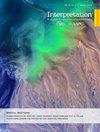基于阿拉伯碳酸盐岩陆架白云岩化机制的区域地层不协调白云岩制图
IF 1.1
4区 地球科学
Q3 GEOCHEMISTRY & GEOPHYSICS
Interpretation-A Journal of Subsurface Characterization
Pub Date : 2023-06-08
DOI:10.1190/int-2022-0116.1
引用次数: 0
摘要
白云石绘图作为碳酸盐岩成岩建模的第一步,对于理解白云石化机制和储层质量预测至关重要。长期以来,人们一直在阿拉伯大陆架上研究上侏罗纪层段内的地层不整合白云岩。所提出的白云石化机制表明,流体运动是白云石化过程中的一个关键因素,而裂缝是控制白云石几何形状的流体运动管道。因此,断层/裂缝作为运移通道,通过控制流体运动来确定白云石化分布。研究区白云岩的圈定是由成岩机制和多尺度断裂系统的综合表征驱动的。根据裂缝的大小和地震波长,将地下复杂裂缝分为宏观裂缝、中尺度裂缝和微尺度裂缝。宏观裂缝,即断层,比地震波长大得多,由于明显的地震反应,可以很容易地在地震剖面上发现。中尺度裂缝略大于或等于地震波长,可以使用地震属性进行识别。微尺度裂缝远小于地震波长,主要可在岩芯样品和薄片上观察到。白云石成图工作流程包括三个步骤:1)利用钻孔图像测井和岩心解释校准地震属性特征;2) 使用多个地震属性实现多尺度裂缝表征;以及3)基于裂缝特征和地质建模来解释白云石体。绘图结果表明,块状白云岩不均匀发育,主要分布在研究区的东北部,白云岩含量向南下降,这一点得到了井基地质模型的验证。研究结果清楚地表明,多尺度断裂系统在块状白云石化中起着关键作用,这为白云石化机制以及地下储层和封盖提供了新的见解。本文章由计算机程序翻译,如有差异,请以英文原文为准。
Regional Stratigraphically Discordant Dolomite Mapping Based on Dolomitization Mechanism on the Arabian Carbonate Shelf
Dolomite mapping as a first step towards a carbonate diagenetic modelling, is critical for understanding the dolomitization mechanism, and reservoir quality prediction. Stratigraphically discordant dolomite bodies within the Upper Jurassic intervals have long been studied on the Arabian Shelf. The proposed dolomitization mechanisms show that fluid movement is a key factor in dolomitization processes, and fracture as conduits of fluid movement controlling dolomite geometry. Therefore, faults/fractures served as migration conduits, determine dolomitization distribution by controlling fluid movement. Dolomite delineation in the study area is driven by the diagenetic mechanisms and comprehensive characterization of fracture systems in multiple scales. The complex fracture in the subsurface are categorized into macroscale, mesoscale, and microscale fractures according to the fracture size and seismic wavelength. Macroscale fractures, i.e. faults, are much greater than seismic wavelength and can be easily picked on seismic sections due to obvious seismic response. Mesoscale fractures are slightly greater or equal to seismic wavelength and can be recognized using seismic attributes. Microscale fractures are far smaller than seismic wavelength and can be observed mainly on core samples and thin-sections. The dolomite mapping workflow includes three steps: 1) calibrate seismic attribute characteristics with borehole image logs and core interpretations; 2) implement multiscale fracture characterization using multiple seismic attributes; and 3) interpret dolomite bodies based on fracture characterization and geological modelling. The mapping results show that massive dolomite bodies are heterogeneously developed and distributed mainly in the northeastern part of the study area, with a southward decrease in dolomite content, which is validated by well-based geological model. The results clearly demonstrate that multiscale fracture systems play critical roles in the massive dolomitization, which provides new insights on the dolomitization mechanism and subsurface reservoir and seal.
求助全文
通过发布文献求助,成功后即可免费获取论文全文。
去求助
来源期刊

Interpretation-A Journal of Subsurface Characterization
GEOCHEMISTRY & GEOPHYSICS-
CiteScore
2.50
自引率
8.30%
发文量
126
期刊介绍:
***Jointly published by the American Association of Petroleum Geologists (AAPG) and the Society of Exploration Geophysicists (SEG)***
Interpretation is a new, peer-reviewed journal for advancing the practice of subsurface interpretation.
 求助内容:
求助内容: 应助结果提醒方式:
应助结果提醒方式:


